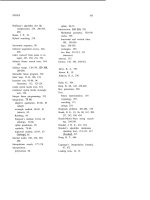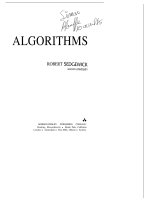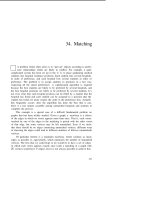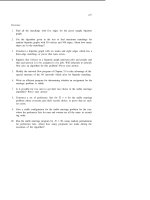Tài liệu Thuật toán Algorithms (Phần 17) pptx
Bạn đang xem bản rút gọn của tài liệu. Xem và tải ngay bản đầy đủ của tài liệu tại đây (115.73 KB, 10 trang )
SELECTION AND MERGING 153
Exercises
1.
For N = 1000, empirically determine: the value of
k
for which the Quick-
sort-based partitioning procedure be :omes faster than using heaps to find
the
Ic
th smallest element in a
randc’m
file.
2.
Describe how you would rearrange an array of 4N elements so that the
N smallest keys fall in the first N
Isositions,
the next N keys fall in the
next N positions, the next N in the next N positions, and the N largest
in the last N positions.
3.
Show the recursive calls made when select is used to find the median of
the keys EASYQUESTION.
4. Write a program to rearrange a
file
so that all the elements with keys
equal to the median are in place, with smaller elements to the left and
larger elements to the right.
5.
What method would be best for an application that requires selection of
the
lath
largest element (for various arbitrary
Ic)
a large number of times
on the same file?
6.
True or false: the running time of mergesort does not depend on the order
of the keys in the input file. Explair. your answer.
7. What is the smallest number of steps mergesort could use (to within a
constant factor)?
8. Implement a bottom-up non-recursive mergesort that uses two arrays
instead of linked lists.
9.
Show the contents of the linked lists
l’assed
as arguments to each call when
the recursive mergesort is used to sort the keys EASY Q U E S T IO N.
10. Show the contents of the linked l&t at each iteration when the
non-
recursive mergesort is used to sort the keys EASY QUE S TIO N.
3. External Sorting
Many important sorting applications involve processing very large files,
much too large to fit into the primal y memory of any computer. Methods
appropriate for such applications are ca.led external methods, since they in-
volve a large amount of processing external to the central processing unit (as
opposed to the internal methods that
we’ve
been studying).
There are two major factors which make external algorithms quite differ-
ent from those we’ve seen until now.
l’irst, the cost of accessing an item
is orders of magnitude greater than any bookkeeping or calculating costs.
Second, even with this higher cost, there are severe restrictions on access,
depending on the external storage medium used: for example, items on a
magnetic tape can be accessed only in a sequential manner.
The wide variety of external storage device types and costs make the de-
velopment of external sorting methods
v~:ry
dependent on current technology.
The methods can be complicated, and many parameters affect their perfor-
mance: that a clever method might go unappreciated or unused because of a
simple change in the technology is a definite possibility in external sorting.
For this reason, we’ll concentrate on general methods in this chapter rather
than on developing specific implementatjons.
In short, for external sorting, the
“s:istems”
aspect of the problem is cer-
tainly as important as the “algorithms”
.ispect.
Both areas must be carefully
considered if an effective external sort is to be developed. The primary costs in
external sorting are for input-output. A good exercise for someone planning
to implement an efficient program to sort a very large file is first to implement
an efficient program to copy a large file, then (if that was too easy) implement
an efficient program to reverse the order of the elements in a large file. The
systems problems that arise in trying tc solve these problems efficiently are
similar to those that arise in external sorts. Permuting a large external file
in any non-trivial way is about as diffictllt as sorting it, even though no key
155
156
CWAPTER 13
comparisons, etc. are required. In external sorting, we are mainly concerned
with limiting the number of times each piece of data is moved between the
external storage medium and the primary memory, and being sure that such
transfers are done as efficiently as allowed by the available hardware.
External sorting methods have been developed which are suitable for the
punched cards and paper tape of the past, the magnetic tapes and disks of
the present, and the bubble memories and videodisks of the future. The es-
sential differences among the various devices are the relative size and speed
of available storage and the types of data access restrictions. We’ll con-
centrate on basic methods for sorting on magnetic tape and disk because these
devices are likely to remain in widespread use and illustrate the two fundamen-
tally different modes of access that characterize many external storage sys-
tems. Often, modern computer systems have a “storage hierarchy” of several
progressively slower, cheaper, and larger memories. Many of the algorithms
that we will consider can be adapted to run well in such an environment, but
we’ll deal exclusively with “two-level” memory hierarchies consisting of main
memory and disk or tape.
Sort-Merge
Most external sorting methods use the following general strategy: make a first
pass through the file to be sorted, breaking it up into blocks about the size
of the internal memory, and sort these blocks. Then merge the sorted blocks
together, by making several passes through the file, making successively larger
sorted blocks until the whole file is sorted. The data is most often accessed in
a sequential manner, which makes this method appropriate for most external
devices. Algorithms for external sorting strive to reduce the number of passes
through the file and to reduce the cost of a single pass to be as close to the
cost of a copy as possible.
Since most of the cost of an external sorting method is for input-output,
we can get a rough measure of the cost of a sort-merge by counting the number
of times each word in the file is read or written, (the number of passes over all
the data). For many applications, the methods that we consider will involve
on the order of ten or less such passes. Note that this implies that we’re
interested in methods that can eliminate even a single pass. Also, the running
time of the whole external sort can be easily estimated from the running time
of something like the “reverse file copy” exercise suggested above.
Balanced Multiway Merging
To begin, we’ll trace through the various steps of the simplest sort-merge
procedure for an example file. Suppose that we have records with the keys A
SORTINGANDMERGINGEXAMPLEonaninputtape;these
EXTERNAL SORTING
157
are to be sorted and put onto an output tape. Using a “tape” simply means
that we’re restricted to read the records
isequentially:
the second record can’t
be read until the first has been, etc. Assume further that we have only enough
room for three records in our computer memory but that we have plenty of
tapes available.
The first step is to read in the file t.lree records at a time, sort them to
make three-record blocks, and output the sorted blocks. Thus, first we read in
A S 0 and output the block A 0 S, next
are
read in R T I and output the block
I R T,and so forth. Now, in order for these blocks to be merged together,
they must be on different tapes. If we want to do a three-way merge, then we
would use three tapes, ending up with the following configuration after the
sorting pass:
Tape
I:
A 0 S
1,
M N A E X
Tape
2:
I R T
El G R L M P
Tape 3: A G N
GIN
E
Now we’re ready to merge the sorted blocks of size three together. We
read the first record off each input tapl: (there’s just enough room in the
memory) and output the one with the smallest key. Then the next record
from the same tape as the record just output is read in and, again, the record
in memory with the smallest key is output. When the end of a three-word
block in the input is encountered, then that tape is ignored until the blocks
from the other two tapes have been processed, and nine records have been
output. Then the process is repeated to merge the second three-word block
on each tape into a nine-word block (whiC1 is output on a different tape, to get
ready for the next merge). Continuing,
we
get three long blocks configured
as follows:
Taped: A A G I N 0 R S T
Tape 5: D E G
G
I M N N R
Tape 6: A E E
1,
M P X
Now one more three-way merge completes the sort. If we had a much
longer file with many blocks of size 9 on each tape, then we would finish the
second pass with blocks of size 27 on tapes 1, 2, and 3, then a third pass
would produce blocks of size 81 on tapes 4, 5, and 6, and so forth. We need
six tapes to sort an arbitrarily large file: three for the input and three for the
CHAPTER 13
output of each three-way merge. Actually, we could get by with just four
tapes: the output could be put on just one tape, then the blocks from that
tape distributed to the three input tapes in between merging passes.
This method is called the balanced multiway merge: it is a reasonable al-
gorithm for external sorting and a good starting point for the implementation
of an external sort. The more sophisticated algorithms below could make the
sort run perhaps 50% faster, but not much more. (On the other hand, when
execution times are measured in hours, which is not uncommon in external
sorting, even a small percentage decrease in running time can be helpful and
50% can be quite significant.)
Suppose that we have N words to be manipulated by the sort and an
internal memory of size M. Then the “sort” pass produces about N/M sorted
blocks. (This estimate assumes l-word records: for larger records, the number
of sorted blocks is computed by multiplying further by the record size.) If
we do P-way merges on each subsequent pass, then the number of subsequent
passes is about logp(N/M), since each pass reduces the number of sorted
blocks by a factor of P.
Though small examples can help one understand the details of the al-
gorithm, it is best to think in terms of very large files when working with
external sorts. For example, the formula above says that using a 4-way merge
to sort a 200-million-word file on a computer with 1 million words of memory
should take a total of about five passes. A very rough estimate of the running
time can be found by multiplying by five the running time for the reverse file
copy implementation suggested above.
Replacement
Selection
It turns out that the details of the implementation can be developed in an
elegant and efficient way using priority queues. First, we’ll see that priority
queues provide a natural way to implement a multiway merge. More impor-
tant, it turns out that we can use priority queues for the initial sorting pass
in such a way that they can produce sorted blocks much longer than could fit
into internal memory.
The basic operation needed to do P-way merging is to repeatedly output
the smallest of the smallest elements not yet output from each of the P blocks
to be merged. That element should be replaced with the next element from
the block from which it came. The replace operation on a priority queue
of size P is exactly what is needed. (Actually, the “indirect” verions of the
priority queue routines, as described in Chapter 11, are more appropriate for
this application.) Specifically, to do a P-way merge we begin by filling up a
priority queue of size P with the smallest element from each of the P inputs
using the pqinsert procedure from Chapter 11 (appropriately modified so that
EXTERNAL SORTING
159
the smallest element rather than the larl;est is at the top of the heap). Then,
using the pqreplace procedure from Chitpter 11 (modified in the same way)
we output the smallest element and replace it in the priority queue with the
next element from its block.
For example, the following table shows the result of merging A 0
S
with
I R T and A G N (the first merge from
‘)ur
example above):
1
2 3
A I A
A
I 0
G I
0
IN0
N R
0
0 R
R S
S T
T
The lines in the table represent the contents of a heap of size three used
in the merging process. We begin with
t1
e first three keys in each block. (The
“heap condition” is that the first key must be smaller than the second and
third.) Then the first A is output and replaced with the 0 (the next key in its
block). This violates the heap condition, so the 0 is exchanged with the other
A. Then that A is output and replaced with the next key in its block, the G.
This does not violate the heap condition, so no further change is necessary.
Continuing in this way, we produce
the!
sorted file (read down in the table
to see the keys in the order in which they appear in the first heap position
and are output). When a block is exhausted, a sentinel is put on the heap
and considered to be larger than all the other keys. When the heap consists
of all sentinels, the merge is completed. This way of using priority queues is
sometimes called replacement selection.
Thus to do a P-way merge, we can use replacement selection on a priority
queue of size P to find each element to be output in
1ogP
steps. This
performance difference is not of particular practical relevance, since a brute-
force implementation can find each elernent to output in P steps, and P is
normally so small that this cost is dwarfed by the cost of actually outputting
the element. The real importance of re’placement selection is the way that
it can be used in the first part of the scrt-merge process: to form the initial
sorted blocks which provide the basis
fo*
the merging passes.
160
CHAPTER 13
The idea is to pass the (unordered) input through a large priority queue,
always writing out the smallest element on the priority queue as above, and
always replacing it with the next element from the input, with one additional
proviso: if the new element is smaller than the last one put out, then, since
it could not possibly become part of the current sorted block, it should be
marked as a member of the next block and treated as greater than all elements
in the current block. When a marked element makes it to the top of the
priority queue, the old block is ended and a new block started. Again, this
is easily implemented with pqinsert and pqreplace from Chapter 11, again
appropriately modified so that the smallest element is at the top of the heap,
and with pqreplace changed to treat marked elements as always greater than
unmarked elements.
Our example file clearly demonstrates the value of replacement selection.
With an internal memory capable of holding only three records, we can
produce sorted blocks of size 5, 4, 9, 6, and 1, as illustrated in the following
table. Each step in the diagram below shows the next key to be input (boxed)
and the contents of the heap just before that key is input. (As before, the
order in which the keys occupy the first position in the heap is the order in
which they are output.) Asterisks are used to indicate which keys in the heap
belong to different blocks: an element marked the same way as the element at
the root belongs to the current sorted block, others belong to the next sorted
block. Always, the heap condition (first key less than the second and third) is
maintained, with elements in the next sorted block considered to be greater
than elements in the current sorted block.
IlLI
0
T
0
I
-
u
N
-
Is-l
-
Ll
A
-
I.4
0
D
Id
-
A
0
R
S
T
G*
1*
N*
N*
S
S
S
I’
I’
I’
A
A
A
0
0
E A M D M A* G* E”
q
-
R
IRI
D M E
IPI
E* G* M*
- -
T
0
G E M R L G* P* M*
0
-
-
T 111 G M R
IEl
L* P*
M”
- -
N’
q
N I M R
0
M’
P* E
- -
N’
Ll
G MN R
u
P*
E
N*
q
E N G* R
0
E
N*
i-d
R G* E*
D
IAl X G* E*
For example, when pqreplace is called for M, it returns N for output (A and
D are considered greater) and then sifts down M to make the heap A M D.
EXTERNAL SORTING
161
It can be shown that, if the keys a-e random, the runs produced using
replacement selection are about twice the size of what could be produced using
an internal method. The practical effect of this is to save one merging pass:
rather than starting with sorted runs about the size of the internal memory
and then taking a merging pass to produce runs about twice the size of the
internal memory, we can start right
of’
with runs about twice the size of
the internal memory, by using replacement selection with a priority queue of
size M. If there is some order in the keys, then the runs will be much, much
longer. For example, if no key has more than M larger keys before it in the
file, the file will be completely sorted by the replacement selection pass, and
no merging will be necessary! This is the most important practical reason to
use the method.
In summary, the replacement seleclion technique can be used for both
the “sort” and the “merge” steps of a balanced multiway merge. To sort N
l-word records using an internal memo y of size M and P + 1 tapes, first
use replacement selection with a priority queue of size M to produce initial
runs of size about 2M (in a random situation) or longer (if the file is partially
ordered) then use replacement selection with a priority queue of size P for
about
log,(N/2M)
(or fewer) merge passes.
Practical Considerations
To complete an implementation of the llorting method outlined above, it is
necessary to implement the inputroutput functions which actually transfer
data between the processor and the ex;ernal devices. These functions are
obviously the key to good performance for the external sort, and they just
as obviously require careful consideratisw of some systems (as opposed to
algorithm) issues. (Readers unfamiliar with computers at the “systems” level
may wish to skim the next few paragraphs.)
A major goal in the implementation should be to overlap reading, writing,
and computing as much as possible. Most large computer systems have
independent processing units for controlling the large-scale input/output (I/O)
devices which make this overlapping
pos:#ible.
The efficiency achievable by an
external sorting method depends on the number of such devices available.
For each file being read or written, there is a standard systems program-
ming technique called double-buffering which can be used to maximize the
overlap of I/O with computing. The idl:a is to maintain two “buffers,” one
for use by the main processor, one for us: by the I/O device (or the processor
which controls the I/O device). For input, the processor uses one buffer while
the input device is filling the other. When the processor has finished using
its buffer, it waits until the input device has filled its buffer, then the buffers
switch roles: the processor uses the
near
data in the just-filled buffer while
162
CHAPTER 13
the input device refills the buffer with the data already used by the processor.
The same technique works for output, with the roles of the processor and
the device reversed. Usually the I/O time is far greater than the processing
time and so the effect of double-buffering is to overlap the computation time
entirely; thus the buffers should be as large as possible.
A difficulty with double-buffering is that it really uses only about half
the available memory space. This can lead to inefficiency if a large number
of buffers are involved, as is the case in P-way merging when P is not small.
This problem can be dealt with using a technique called forecasting, which
requires the use of only one extra buffer (not P) during the merging process.
Forecasting works as follows. Certainly the best way to overlap input with
computation during the replacement selection process is to overlap the input
of the buffer that needs to be filled next with the processing part of the
algorithm. But it is easy to determine which buffer this is: the next input
buffer to be emptied is the one whose lust item is smallest. For example, when
merging A 0
S
with I R T and A G N we know that the third buffer will be
the first to empty, then the first. A simple way to overlap processing with
input for multiway merging is therefore to keep one extra buffer which is filled
by the input device according to this rule. When the processor encounters an
empty buffer, it waits until the input buffer is filled (if it hasn’t been filled
already), then switches to begin using that buffer and directs the input device
to begin filling the buffer just emptied according to the forecasting rule.
The most important decision to be made in the implementation of the
multiway merge is the choice of the value of P, the “order” of the merge. For
tape sorting, when only sequential access is allowed, this choice is easy: P
must be chosen to be one less than the number of tape units available: the
multiway merge uses P input tapes and one output tape. Obviously, there
should be at least two input tapes, so it doesn’t make sense to try to do tape
sorting with less than three tapes.
For disk sorting, when access to arbitrary positions is allowed but is
somewhat more expensive than sequential access, it is also reasonable to
choose P to be one less than the number of disks available, to avoid the
higher cost of non-sequential access that would be involved, for example, if
two different input files were on the same disk. Another alternative commonly
used is to pick P large enough so that the sort will be complete in two merging
phases: it is usually unreasonable to try to do the sort in one pass, but a
two-
pass sort can often be done with a reasonably small P. Since replacement
selection produces about
N/2M
runs and each merging pass divides the
number of runs by P, this means P should be chosen to be the smallest integer
with
P2
> N/2M. For our example of sorting a 200-million-word file on a
computer with a l-million-word memory, this implies that P = 11 would be a
safe choice to ensure a two-pass sort. (The right value of P could be computed









